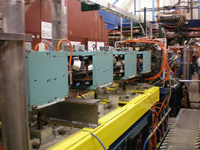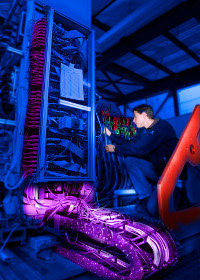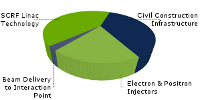 |
|
|
 |
From SLAC Today: Clobbering Electron Clouds

Magnets in blue-green boxes hug the beam pipe at CesrTA. This setup tests how magnetic fields affect electron clouds.
Image: Mark Palmer |
Researchers at SLAC and other institutions are creating a sort of pest control for particle beams: squashing the clouds of electrons that gather in accelerators and disrupt experiments.
“Some methods are already there... we know they work,” said Mauro Pivi, a SLAC scientist in the Accelerator Design Department. But in order for future colliders such as the proposed International Linear Collider, or ILC, to carry off experiments of unprecedented energy, the beams must be perfect and the pipes pristine. “Even a small electron cloud could be a problem,” Pivi said.
Colliders delve for the universe's secrets by smashing together oppositely charged subatomic particles and examining the resulting debris. The particles accelerate toward their collision point as tightly focused bunches traveling through two long beam pipes. But particles emanating from the bunches often knock electrons from the walls of the beam pipe. These electrons bump into others. Soon the pipe hosts a cloud of electrons that ruins the beam's focus, or emittance. As a result, the colliding bunches lose their wallop.
Read more...
-- Olga Kuchment |
 |
|
|
 |
|
 |
Returning victorious
AIDA proposal gets excellent grades

Test beams and particle-flow calorimeters are on the long to-do list of the AIDA project.
Image: Fermilab |
The Advanced European Infrastructures for Detectors at Accelerators (AIDA) proposal has received top grades from the European Commission, meaning that the multi-disciplinary multi-institutional detector development project will definitely go ahead. Out of 47 submitted proposals, AIDA came second with a score of 14.5 out of 15. The only catch is that the EC cut the proposed funding from 10 to 8 million Euros, reducing the full funding to just under 28 million Euros over four years. The project partners are now in the process of redefining the scope of the project in order to match the new budget, but are planning to keep as much as possible to the originally foreseen work. The coordinators and the EC are currently in a negotiation phase and the starting date of AIDA is expected for early 2011.
Read more...
-- Barbara Warmbein |
 |
|
|
 |
From newelectronics.co.uk
10 May 2010
Recreating the Big Bang
"How electronics technology is underpinning the search for the Higgs boson and other fundamental particles."
Read more... |
|
From physicsworld.com
6 May 2010
Dark matter 'no result' comes under fire
“For me the best answer is not in words but in measurements,” she explains. “I understand that he feels not too good about our results, [and] in the end he can say all he wants, but there is simply no sign of hypothetical 7 GeV WIMPs in our data, and we state that very clearly.”
Read more... |
|
From Gazeta.ru
5 May 2010
Not worse than the Sochi Olympic Games
Read more... (in Russian) |
|
From Nature.com
4 May 2010
Dark matter stays dark
"The result, now on the preprint server arXiv.org, undercuts previous claims of dark matter detection. Basically, if earlier experiments really have seen something, then XENON 100 would be likely to see it too."
Read more... |
|
From CERN Bulletin
3 May 2010
It's time for physics
"Retracing and rediscovering known particles is part of the training process that the LHC experiments are diligently going through during these first weeks of operation."
Read more... |
|
|
 |
 |
|
|
 |
Keeping ILC costs under control

The ILC cost breakdown. |
The cost of the project "next-generation linear collider" ILC has been a major issue, ever since we began our ILC design work in 2005. The scale of the project and the costs of the ILC are roughly equivalent to the largest present-day science projects, like the International Thermonuclear Experimental Reactor (ITER), and the Large Hadron Collider (LHC). The good news is that we believe the ILC will not cost more than these megascience projects, and they have actually been built or are being built. The bad news is that the present world economic situation and government priorities are such that it will be extremely difficult to convince governments to make yet another large investment in a fundamental science project of such a large scale. Nevertheless, fundamental science must go on, and it remains probable that new megascience projects will be undertaken in the future, probably as global projects. A linear collider is a very attractive, and convincing, candidate project.
Read more...
-- Barry Barish
Director's Corner Archive |
 |
|
|
 |
|
arXiv preprints
01005.1070
Solving the μ problem with a heavy Higgs boson
01005.0818
Dirac Neutralinos and Electroweak Scalar Bosons of N=1/N=2 Hybrid Supersymmetry at Colliders
1005.0761
SUSY dark matter in light of CDMS II results: a comparative study for different models
1005.0695
Standard candle central exclusive processes at the Tevatron and LHC
|
|

